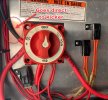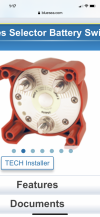Baxter
Well-Known Member
I was investigating my boat wiring further, and realized something seemed amiss...
Photo of switch below.
The positive feed from the kicker is tied to battery 1, rather than the "1+2" spot... this seems wrong.
From what I can tell it is still working correctly though. If the switch is turned to any (1/2/1+2) the kicker runs just fine. If the switch is to "off" it does not. So it SEEMS good, but this still seems wrong. To me, what this is doing is having the kicker always pull from battery 1. - but it also surprises me - the connection is essentially always connected to battery 1 this way, but yet still won't start if switch is off. Am I the moron?
Am I crazy? Should that black positive line for the kicker not be connected to "1+2"? That particular wire was done by the dealer, so I always assumed it to be correct. Never second guessed it, but now, as I look into adding a fuse block, and redoing a few things, this has me shaking my head.
Am I dumb, or is this wrong?
My impression on how it should go:
1 = Positive lead from battery 1
2 = Positive lead from battery 2
1/2 = positive lead to everything else.
Photo of switch below.
The positive feed from the kicker is tied to battery 1, rather than the "1+2" spot... this seems wrong.
From what I can tell it is still working correctly though. If the switch is turned to any (1/2/1+2) the kicker runs just fine. If the switch is to "off" it does not. So it SEEMS good, but this still seems wrong. To me, what this is doing is having the kicker always pull from battery 1. - but it also surprises me - the connection is essentially always connected to battery 1 this way, but yet still won't start if switch is off. Am I the moron?
Am I crazy? Should that black positive line for the kicker not be connected to "1+2"? That particular wire was done by the dealer, so I always assumed it to be correct. Never second guessed it, but now, as I look into adding a fuse block, and redoing a few things, this has me shaking my head.
Am I dumb, or is this wrong?
My impression on how it should go:
1 = Positive lead from battery 1
2 = Positive lead from battery 2
1/2 = positive lead to everything else.

Last edited:


